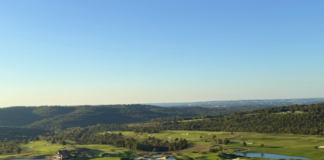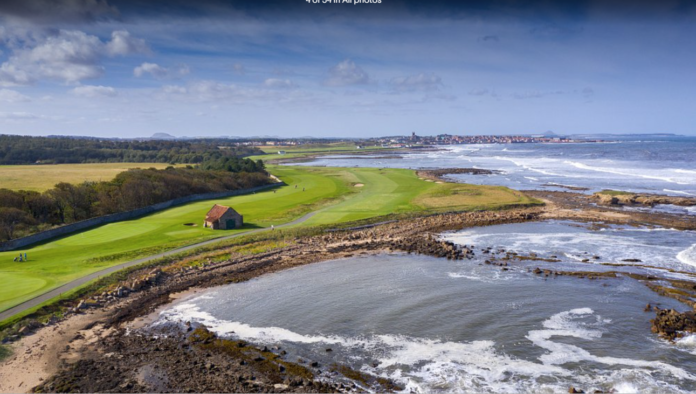
EDINBURGH, Scotland – The wind was blowing steadily at around 40 mph, and then the rain came, stinging our faces as we trudged with our heads down along the fairway. I looked to my left to see my friend sprinting after his trolley, which the wind had caught hold of and had sent careening down a hill. It wasn’t long after when he shouted through the howling wind, “I haven’t had this much fun playing golf in a long time.”
This was true Scottish weather, on a breath-taking links course that is seemingly carved into the side of a mountain, and while it might not have been what we wanted to encounter every day, it sure told us exactly where we were.
We had arrived in Scotland 10 days earlier in the wee hours of the morning, as one usually does when traveling from the United States, landing in Edinburgh at around 6 a.m. This was a golf trip two years in the planning, taken with three high school friends, Mr. Moore, Schmitty and the Piano Man, from, and I have trouble uttering these words, 50 years ago. It would consist of eight rounds of golf in nine hectic days, with a series of two-hour drives through seemingly thousands of roundabouts to destinations not usually taken on such excursions.
When we last made such a trip in 2004, we played all the usual suspects. Carnoustie. Turnberry. Muirfield. Troon. Prestwick. North Berwick West Links. Kingsbarns. And, of course, the Old Course at St. Andrews. But this was to be a trip to hidden gems that were extraordinary in their own right, were mostly seaside and were largely off the radar.
Day One: The Castle Course, St. Andrews
Our trip began at one of the newest, most controversial courses in Scotland. Designed by David McLay Kidd, the Castle Course opened in 2008 and almost immediately drew criticism for its modern, manufactured look, its occasionally quirky holes and its severely sloped greens. But the course has been softened over nearly 20 years, and the criticism has been muted. But make no mistake, it remains difficult and visually intimidating, measuring 6,749 yards from the championship tees and playing to a par 71. We selected the silver tees, and it felt like 7,000 yards.
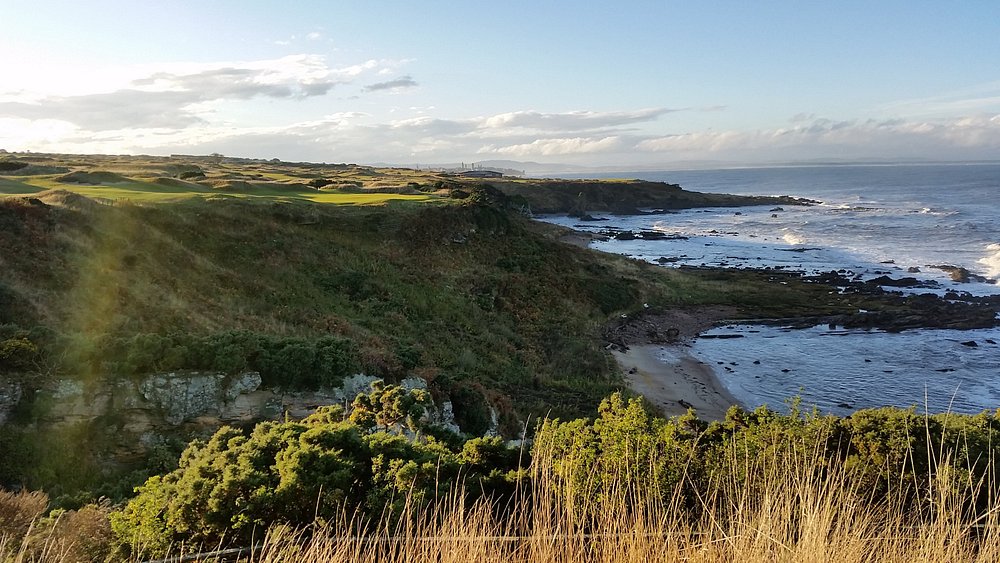
It is one of the most eye-popping courses I’ve ever played, offering magnificent views of the town of St. Andrews, St. Andrews Bay and the North Sea. The dramatic elevation changes are evident from the moment you arrive as you drive to the clubhouse, where a series of seaside holes perched on cliffs and framed by the ocean unfold before your eyes.
The course routing heads inland towards St Andrews at the start before turning back to the clubhouse along the coast from the sixth hole on, where you are treated to a fabulous view across the water to the town of St. Andrews. The back nine then heads inland again, away from the town, before closing with a stunning clifftop finish.
The holes throughout the course rise up like a roller-coaster before tumbling back down, with the closing stretch strung out along the coastline. The par-4 12th is a brute at 449 yards from the back tees (419 from blue and 387 from silver), demanding a precise drive to a spaghetti-like fairway dotted with deep bunkers on both sides.
But the signature hole is the par-3 17th, which plays across a ravine on the edge of the cliffs. It’s 179 yards from the middle tees, with 160 yards a carry over the cliffs to reach the green. The finishing par-5 18th is no picnic, either, with the cliff again on the right side and a fairway that twists from left to right, with bunkers just about everywhere.
I had arrived at the Castle Course wary that it would be the weakest link of the courses on the trip. But I departed with the feeling that it offered a stimulating series of holes and staggering views that would be difficult to match.
Following golf, we journeyed into the town of St. Andrews, walking the quaint cobblestone streets and making the pilgrimage to the Old Course, where photos were taken on the Swilcan Bridge and time was spent at the Dunvegan’s corner bar, just a pitching wedge from the 18th green, where photos of virtually every legendary golfer of the past 50 years (and many other celebrities) line the walls and ceiling. During the week, we would also have a single malt scotch at Rusack’s Hotel and visit Young Tom Morris’ grave at the town’s historic cemetery.
Day Two: Western Gailes Golf Club, Irvine
I love a true Scottish links courses that is rich with history and, of course, deep heather, thick gorse, sky high sand dunes, dastardly pot bunkers, all usually buffeted by wind and occasionally rain. It’s why I came to Scotland. And it’s why one must visit Western Gailes, where you’ll be walking in the footsteps of the game’s legends, from Harry Vardon and Gene Sarazen to Gary Player, Tom Watson and Rory McIlroy.
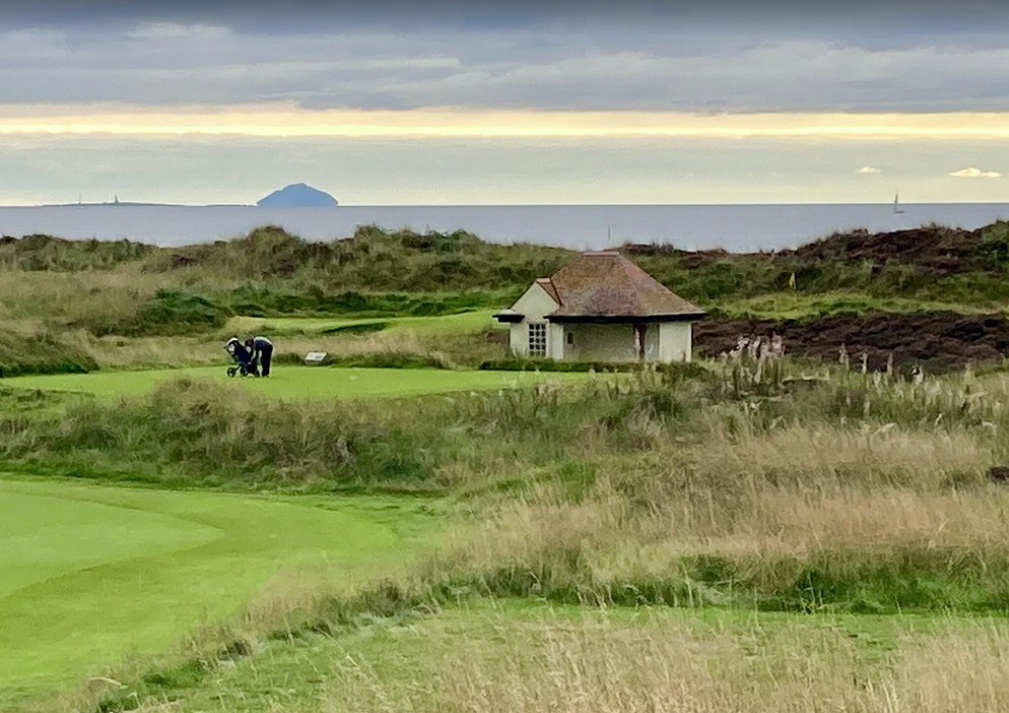
You can’t take the train to Western Gailes anymore, as golfers could until 1966, but it’s worth the journey by car to this classic links layout that sits on a narrow strip of land between the railway and the sea.
It’s only 6,100 yards from the members’ tees, but there is more than enough challenge. Nearly half the greens lie in saucers or bowls that will gather the ball, but once there you will encounter subtle slopes that make putting difficult. It can be punishing, and our scores on this day were the highest we recorded on the trip, but there is never any doubt you are experiencing a championship test of links golf.
Most of the holes have remained untouched since 1898. The coastline comes into view on the fifth hole and remains for nine straight holes, providing looks at the Isle of Arran and the granite behemoth known as Ailsa Craig that is more commonly associated with Turnberry, site of numerous Open championships.
The seventh hole, called “Sea,” plays 171 yards from the members tee and is unforgettable, demanding a precise drive and offering a majestic view. The par-5 14th, which runs along the railway and features 10 bunkers, has been ranked as one of the world’s 500 greatest holes. And the par-4 17th, which is a monster at 443 yards, requires length and accuracy to hit the green in two. Somehow, I managed par, as did Mr. Moore.
When play was completed, our day at Western Gailes was far from over. Here, you are considered a member for the day, and after a pint or two in the bar that overlooks the 18th green, we were ushered into the dining room for dinner, which is included in the daily fees. It’s a wonderful way to end the day, regardless of what sort of crooked numbers are written onto your card.
Day 3: Cruden Bay Golf Club, Cruden Bay
Some courses present themselves as dazzling from the moment you arrive on property. Cruden Bay Golf Club is one such course. As you walk down a hill and around a corner from the parking lot to the pro shop, the course unfolds before your eyes, resting in a valley that beckons you to the first tee.
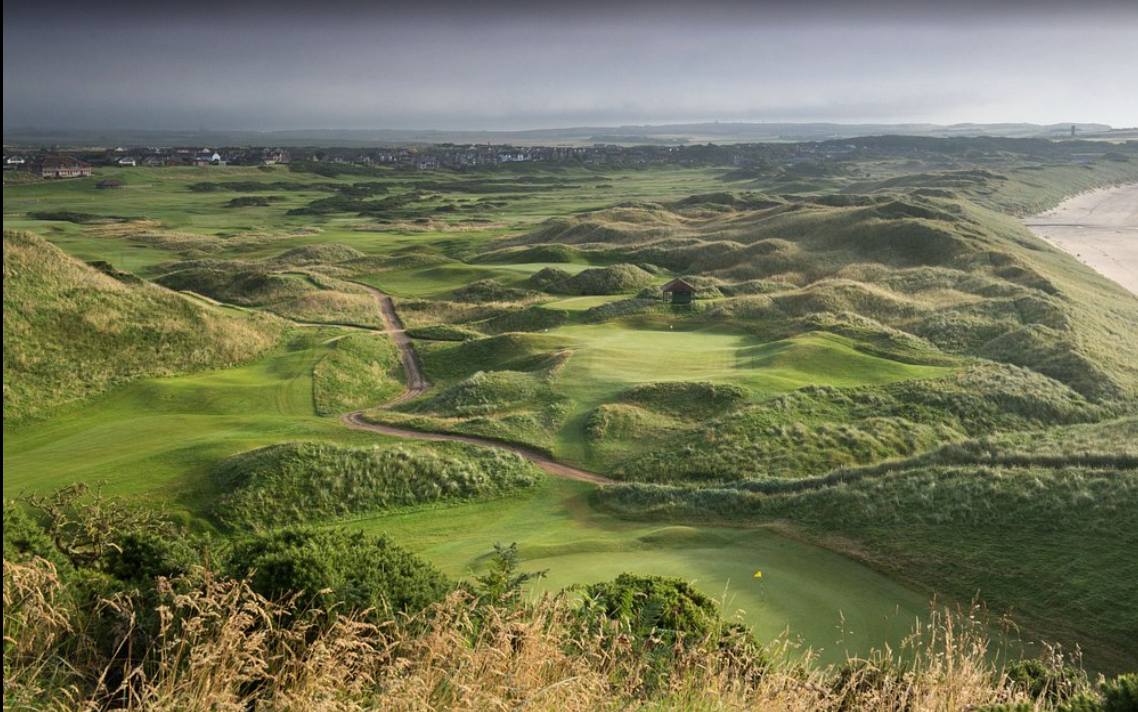
There is evidence that the course dates to 1791, but it officially opened in 1899, with Old Tom Morris as the designer. The first two days featured a professional tournament that included Vardon, and it has since attracted famous golfers from around the globe.
This is a traditional links course, with mammoth dunes, sprawling ocean views and dramatic elevation changes. Greens sit in tiny hollows, there are blind shots galore and many of the holes are secluded from each other by the sand dunes, created a wonderful sense of intimacy. The ruins of Slains Castle, which inspired Bram Stoker to write Dracula, provide a backdrop to the golf. This is Scottish golf in its purest form. It’s little wonder that Cruden Bay has been called the Ballybunion of Scotland.
The opening two holes provide a sense of the adventure that awaits. On the first hole, the fairway slopes severely from left to right, and the approach is to a green that seems to sit in the sky. On the second hole, a monster false front protects a severely crowned green.
You truly know you’re somewhere distinctive when you reach the par-4 fourth hole, where you must wait for a light to turn green before hitting a blind tee shot. Next comes a par-3 of 195 yards that is simply splendid. Framed by stately dunes to the right and a river to the left, you must carry a chasm to reach the green.
The seventh hole, a par-4 of 392 yards from the members’ tees, has a ski slope of a fairway running straight uphill, with an approach that feels like you’re hitting down a bowling alley. And then you reach the eighth hole, high on a hill, with an unforgettable view toward Slains Castle. That’s followed by a long uphill walk through the dunes to the ninth tee, where you stand 300 feet above the water and look down upon the entire golf course. It’s simply an astonishing spot.
Cruden Bay, with its rugged linksland, sand dunes, elevated tees, punchbowl greens, steep collection areas, deep pot bunkers, ocean views, and gorse that seems to glow, all against the backdrop of the North Sea, is one of those courses you should not miss on any trip to Scotland.
Day 4: Dunbar Golf Club, Dunbar
The first thing I noticed was the stone wall separating the first three holes from the remainder of the golf course. Then there are the continuous ocean views that are visible from the fourth to 17th holes. Finally, the flatness of the terrain, and the strategically placed pot bunkers stood out, making for a relaxing walk but not an easy challenge.
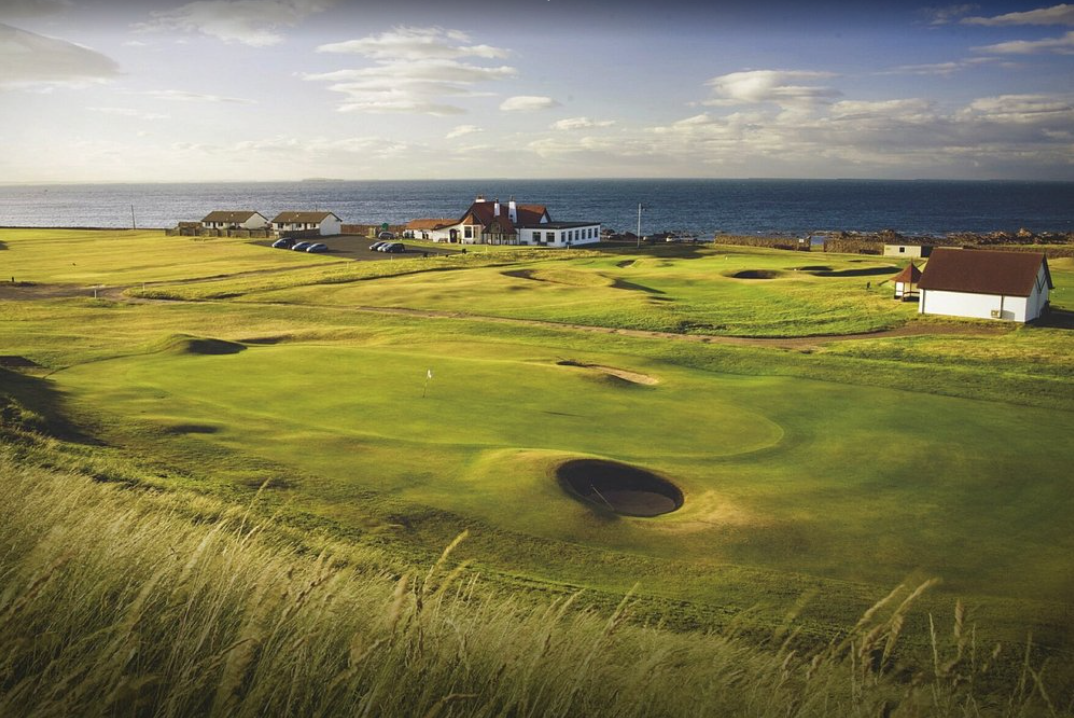
The vibe at Dunbar Golf Club is tranquil, and you can feel the 400 years of history with every footstep, knowing that this slender strip of linksland that sits between an old red sandstone deer park wall and the rocky shoreline was redesigned over the years by the likes of Old Tom Morris and has hosted Open qualifying.
After starting with a pair of relatively tame holes, the fun begins at the 152-yard par-3 third, which is downhill to a green protected by bunkers, slopes, hollows and out-of-bounds to the left, where the clubhouse seems like it’s only inches away.
Then, you walk through the wall to the fourth tee, and what lays ahead for the next 14 holes is pure links golf. The fourth, a par-4 of only 340 yards, is called “Shore” for good reason, as it is framed by the sea on the left and the wall on the right, creating a treacherously tight fairway.
The wall is in play once again on the par-4 sixth, where it runs along the right side. The closer you play your tee shot to the wall, the better angle you will have to a sloping green that is guarded by water in front. Of course, OB lurks.
The par-4 14th hole, a beefy 413 yards from the members’ tees, is considered the signature hole. It features a stunning view back down to the old boathouse, with the Bass Rock looming on the horizon.
But the par-3 16th might have been my favorite hole. At 145 yards, it seems benign, but good luck holding the green. Balls that run long end up on a path or, worse, against the wall. It reminded me of the famous Road Hole at St. Andrews.
A pint or two at the old school clubhouse afterward is definitely required to cap a day that feels exactly like what Scottish golf is meant to be.
Day 5: Panmure Golf Club, Barry
Panmure Golf Club is about as understated a golf course as you will find, but with a rich history that includes none other than Ben Hogan. Located a short drive from the famous Carnoustie Golf Links, all it takes is a walk through the grand old clubhouse, where historic photographs line the walls and memorabilia is everywhere, to begin to understand what Panmure is about.

Hogan didn’t just play a round of golf here; he spent two weeks practicing at Panmure in preparation for the 1953 Open Championship at Carnoustie, which he won. His legacy at Panmure is cemented at the par-4 sixth hole, which bears his name, and the deep bunker guarding the right side of the green that is called “Hogan’s bunker.” It was his suggestion that the bunker be placed there to improve the hole.
Originally designed by Old Tom Morris in 1899 and renovated by five-time Open champ James Braid in 1937, Panmure is deceptively difficult, with undulating greens and natural sandhills that require strategy and skill to navigate. It’s only 6,551 yards from the tips, although a par-70, and it’s a fairly flat walk, with light rough, although there is plenty of heather. But hidden pot bunkers are cleverly placed and seem to come into play on just about every hole. On many holes, the play is to keep the ball low and watch it run across the hard-rock fairways onto the green.
The aforementioned sixth is the signature hole. The long par-4 plays over heather to a blind fairway before proceeding up the hill to a small green. There are hazards all around, with “Hogan’s bunker” short and to the right.
Following the round, make sure to take time to visit the clubhouse, to which you will have access to the bars, restaurant, lockers and showers. Waiting for you will be four 8-by-10 photographs of your foursome that were taken on the first tee, with the shell emblem in the foreground
Panmure does not attract many tourists. But those in the know, and those looking for a unique experience, understand it should not be dismissed.
Arbroath Golf Links, Arbroath
From Panmure, we journeyed to Arbroath Golf Links, also near Carnoustie and another course originally designed by Old Tom Morris in 1877 and redesigned by Braid in 1931. This seaside links truly took us back in time, as Mr. Moore said, to the feeling of playing a golf course that locals have enjoyed for more than a century before the influx of tourism that has impacted so many other Scottish gems.
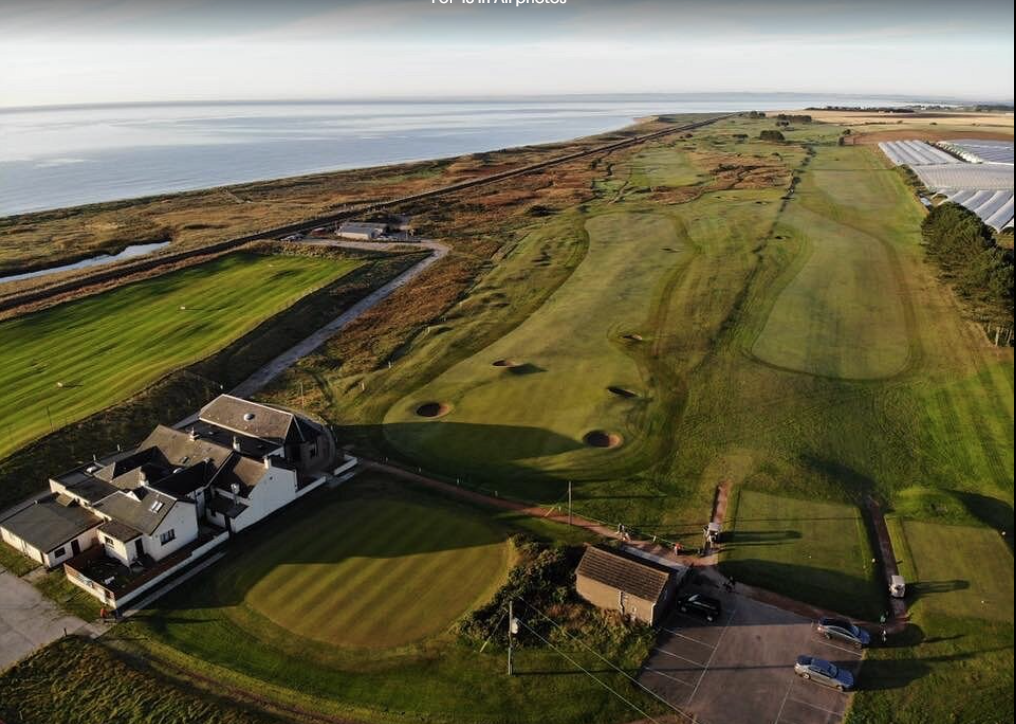
The course plays to a par-70 at only 6,185 yards, which would suggest an undemanding day. But farmland on the right borders the first seven holes, burns cross the fairway on nine occasions, and those ever-pesky bunkers seem to be everywhere. Toss in a sea breeze that is always in evidence and you’ll find ample ways to get into trouble.
The first of the par-3 holes, the 166-yard fourth, is a prime example. Surrounded by a burn to the front and right of the green, there are also four bunkers. One club member allegedly lays up short of the burn on his tee shot and regular makes par with a chip and a putt.
That is followed by the most difficult hole on the course, the 400-yard par-4 fifth. Depending on the wind, it can take as many as four shots to reach the green due to the burn that meanders across the fairway around 60 yards short of the green. There is also OB all the way down the right and three excellently placed bunkers down the left.
The signature hole is considered to be the 14th, a par-3 of 238 yards. Good luck reaching in regulation when playing it into the wind.
With all that said, this was the most stress-free round of golf on our trip, with little rough to fret about, no real fear of losing golf balls (of which we had all lost plenty to that point) and wonderful seaside views throughout.
Gullane Golf Club No. 1, Gullane
Although much of this trip across Scotland was discovering hidden golf gems, Gullane Golf Club No. 1 is anything but that. No other course in East Lothian, other than Muirfield, has hosted more professional tour events, Open qualifying, or national and international amateur championships.
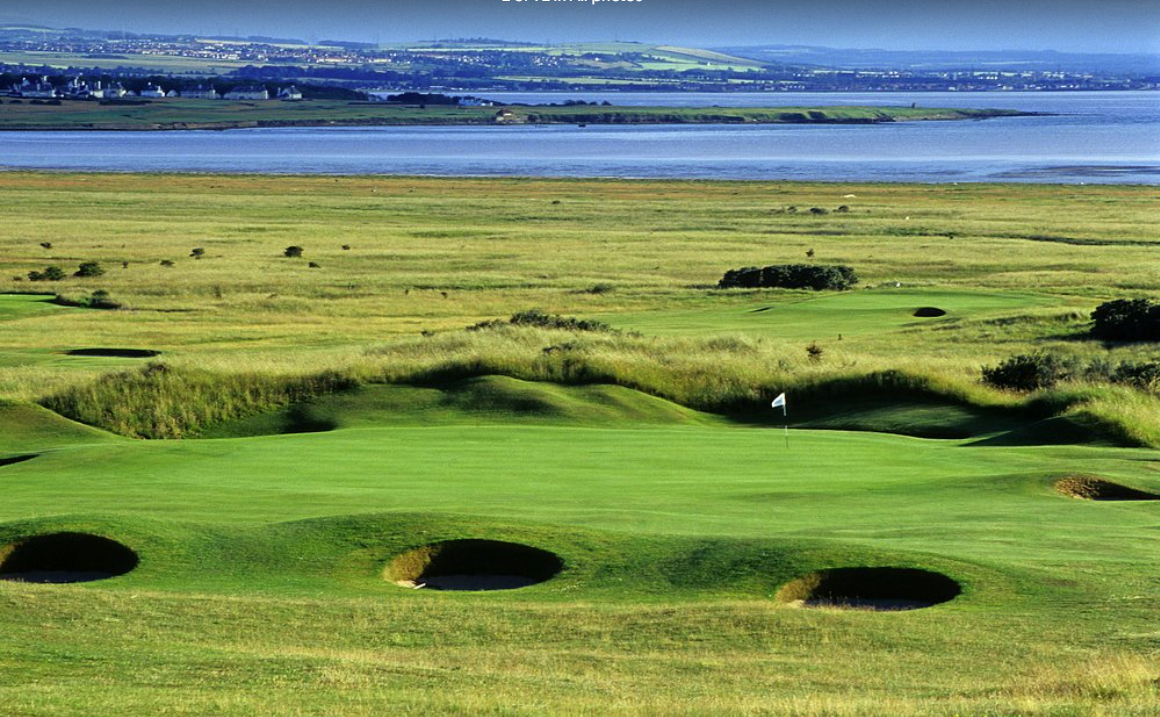
Golf is everywhere in this quaint village, from the Children’s Course by The Old Clubhouse bar to former Open champion Jack White’s hickory golf shop to the historic pubs.
Gullane Golf Club has three championship courses, but No. 1 is the most famous. The first tee and pro shop sit at a street corner in the heart of downtown and give little hint of what lies ahead. But it’s not long before you begin to understand what Gullane has to offer. The second hole, a par-4 of 390 yards from the members’ tees, plays much, much longer. That’s because you could hold an Olympic downhill race on its fairway, which is also about as wide as a bowling alley. Once you reach the green at what feels like the top of the world, the entire golf course sits below you.
From that point, you’re on a journey up, over and around Gullane Hill, across rolling terrain of deep fescue and gorse, with no less than 124 bunkers, undulating greens and some of the most majestic views you will ever find.
The highest point on the course is at the seventh tee, which offers 360-degree views of East Lothian, Edinburgh, Fife and beyond. Keep your camera handy.
The par-3 ninth hole, with no fewer than nine pot bunkers, plays downhill alongside the clifftop, while the green and the adjacent 10th tee provide still more marvelous views over the Firth of Forth. At the long par-5 12th, you’re treated to a stunning view down the beach of Gullane Bents.
On and on it goes. You’re pretty much playing up an enormous hill, and hitting shots along a towering cliff with eye-popping views of the sea until you come down again. From beginning to end, Gullane is one of the most unique, stunning courses I have ever played.
Glen Golf Club East Links, North Berwick
Mention to most golfers that you visited North Berwick and they will immediately assume you played the famous West Links. But just across town is the East Links of Glen Golf Club, which is more reasonably priced and less of a so-called “must-play” course, but nearly equal in its beauty.

For our final round on this Scottish excursion, we discovered a course that might have been our favorite. From the moment we reached the top of the mountainous hill that is the first fairway, we were treated to a seaside landscape atop a cliff, with views stretching across the Firth of Forth to Bass Rock and the island of Fidra, then beyond to the Kingdom of Fife.
For 16 holes, we played along the cliffs, with the coastline a constant presence, the wind always howling, and the rain occasionally pelting our faces. How strong was the wind? On the par-5 fifth hole, I hit a 3-wood onto the green from 246 yards, thanks to the wind at my back. Two holes later, with the wind now in my face, I hit the same 3-wood from 150 yards and came up short.
The course is only 6,275 yards from the tips, playing to a par-70, but the wind clearly dictates what sort of challenge you will face on a given day.
Three of the four par-3 holes are over 180 yards, but the signature hole is the 13th, which hugs the coastline and is a blind par-3 of 148 yards downhill to a green with water long and to the right.
The closing hole sits high on the cliffs, offering one final spectacular view, before you descend down the hill back to sea level. It was an appropriate way to end our trip of hidden gems at a course that plays second fiddle to its neighbor across town, but has every right to take center stage on its own.










